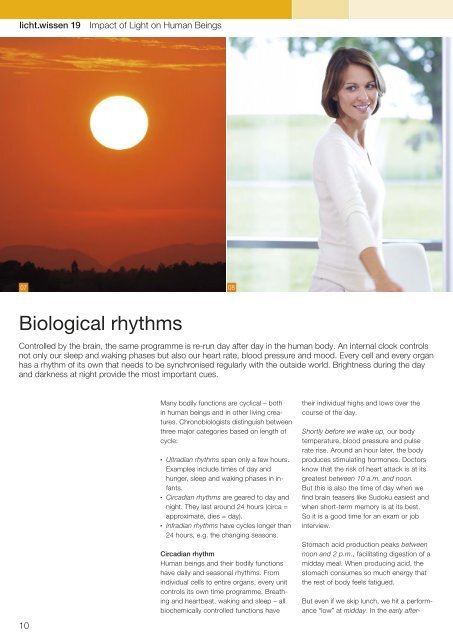licht.wissen 19 No. "Impact of Light on Human Beings"
Light synchronises our “internal clock”. Lighting that copies daylight has more than just a visual impact; it supports bodily functions 24 hours a day. Booklet 19 is intended for all those who want to delve into the topic of Impact of Light on Human Beings. The 56 pages helps to get an overview of what melanopic light can effect. Free Download at www.licht.de/en
Light synchronises our “internal clock”. Lighting that copies daylight has more than just a visual impact; it supports bodily functions 24 hours a day. Booklet 19 is intended for all those who want to delve into the topic of Impact of Light on Human Beings. The 56 pages helps to get an overview of what melanopic light can effect. Free Download at www.licht.de/en
You also want an ePaper? Increase the reach of your titles
YUMPU automatically turns print PDFs into web optimized ePapers that Google loves.
But even if we skip lunch, we hit a performance<br />
“low” at midday. In the early after<str<strong>on</strong>g>licht</str<strong>on</strong>g>.<str<strong>on</strong>g>wissen</str<strong>on</strong>g><br />
<str<strong>on</strong>g>19</str<strong>on</strong>g><br />
<str<strong>on</strong>g>Impact</str<strong>on</strong>g> <str<strong>on</strong>g>of</str<strong>on</strong>g> <str<strong>on</strong>g>Light</str<strong>on</strong>g> <strong>on</strong> <strong>Human</strong> Beings<br />
07 08<br />
Biological rhythms<br />
C<strong>on</strong>trolled by the brain, the same programme is re-run day after day in the human body. An internal clock c<strong>on</strong>trols<br />
not <strong>on</strong>ly our sleep and waking phases but also our heart rate, blood pressure and mood. Every cell and every organ<br />
has a rhythm <str<strong>on</strong>g>of</str<strong>on</strong>g> its own that needs to be synchr<strong>on</strong>ised regularly with the outside world. Brightness during the day<br />
and darkness at night provide the most important cues.<br />
10<br />
Many bodily functi<strong>on</strong>s are cyclical – both<br />
in human beings and in other living creatures.<br />
Chr<strong>on</strong>obiologists distinguish between<br />
three major categories based <strong>on</strong> length <str<strong>on</strong>g>of</str<strong>on</strong>g><br />
cycle:<br />
<br />
<br />
<br />
Ultradian rhythms span <strong>on</strong>ly a few hours.<br />
Examples include times <str<strong>on</strong>g>of</str<strong>on</strong>g> day and<br />
hunger, sleep and waking phases in infants.<br />
Circadian rhythms are geared to day and<br />
night. They last around 24 hours (circa =<br />
approximate, dies = day).<br />
Infradian rhythms have cycles l<strong>on</strong>ger than<br />
24 hours, e.g. the changing seas<strong>on</strong>s.<br />
Circadian rhythm<br />
<strong>Human</strong> beings and their bodily functi<strong>on</strong>s<br />
have daily and seas<strong>on</strong>al rhythms. From<br />
individual cells to entire organs, every unit<br />
c<strong>on</strong>trols its own time programme. Breathing<br />
and heartbeat, waking and sleep – all<br />
biochemically c<strong>on</strong>trolled functi<strong>on</strong>s have<br />
their individual highs and lows over the<br />
course <str<strong>on</strong>g>of</str<strong>on</strong>g> the day.<br />
Shortly before we wake up, our body<br />
temperature, blood pressure and pulse<br />
rate rise. Around an hour later, the body<br />
produces stimulating horm<strong>on</strong>es. Doctors<br />
know that the risk <str<strong>on</strong>g>of</str<strong>on</strong>g> heart attack is at its<br />
greatest between 10 a.m. and no<strong>on</strong>.<br />
But this is also the time <str<strong>on</strong>g>of</str<strong>on</strong>g> day when we<br />
find brain teasers like Sudoku easiest and<br />
when short-term memory is at its best.<br />
So it is a good time for an exam or job<br />
interview.<br />
Stomach acid producti<strong>on</strong> peaks between<br />
no<strong>on</strong> and 2 p.m., facilitating digesti<strong>on</strong> <str<strong>on</strong>g>of</str<strong>on</strong>g> a<br />
midday meal. When producing acid, the<br />
stomach c<strong>on</strong>sumes so much energy that<br />
the rest <str<strong>on</strong>g>of</str<strong>on</strong>g> body feels fatigued.

















